Family : Gobiidae

Text © Giuseppe Mazza

English translation by Mario Beltramini
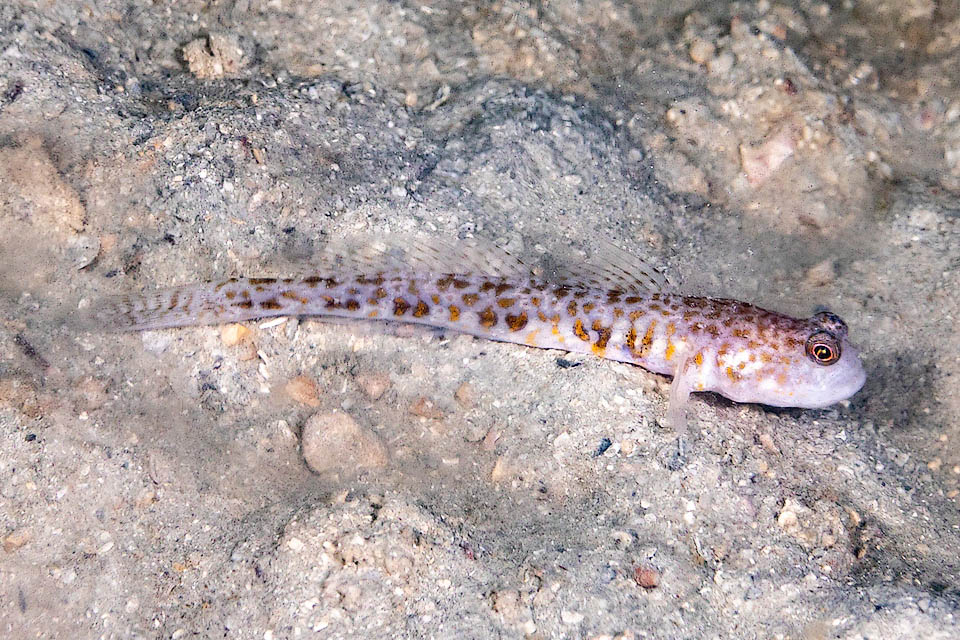
As the scientific name state, Nes longus is a fusiform goby with elongated look © Allison & Carlos Estape
The gobies living on the sandy bottoms are often easy prey if they do not find a den where to hide.
We have seen the elegant Crab-eyed goby (Signigobius biocellatus) that since young with bites digs deep dens throwing out the sand from the gills and then, once found a partner, enlarges the house and lives as a couple.
In the family of the Congridae, the Garden eels (Heteroconger longissimus) go up and down one close to the other through narrow passages; they also take refuge into the underground, at the first sign of danger.
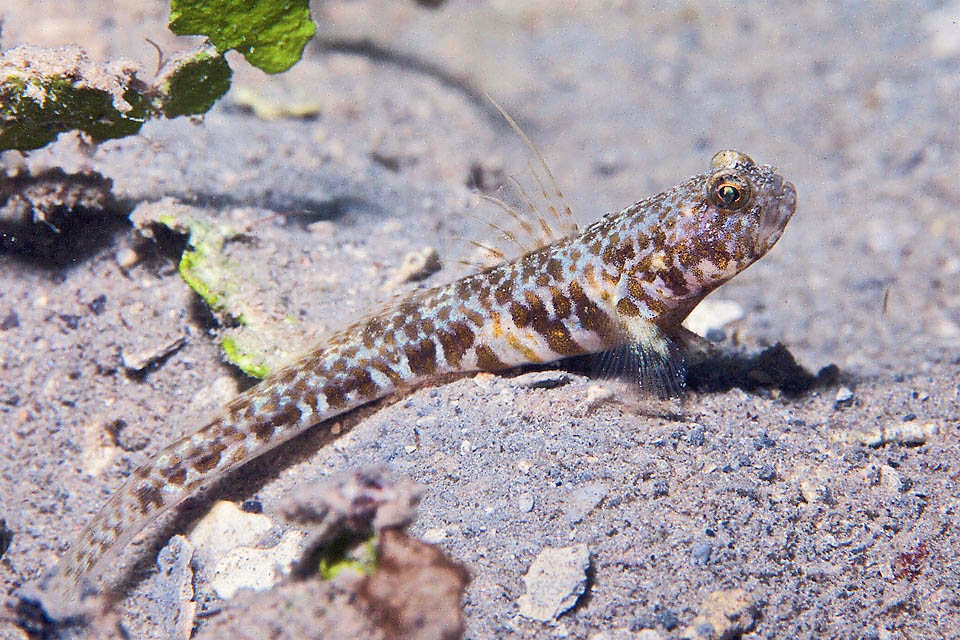
It lives on the sandy Caribbean seabeds where, with no den nearby, it’s not easy to escape the sight of predators © Allison & Carlos Estape
In the Caribbean, there is an unarmed goby, Nes longus (Nichols, 1914), who, being unable to dig its own den, is inextricably linked for life with a skilled burrowing shrimp, Alpheus floridanus Kingsley, 1878, it too easy prey in the open because bad-sighted and does not notice in time the arrival of the predators.
So these two species have been living together from millennia as obligatory symbionts: the fish finds a safe den, cleaned every day by the crustaceans, and this is alerted by the goby in case of danger.
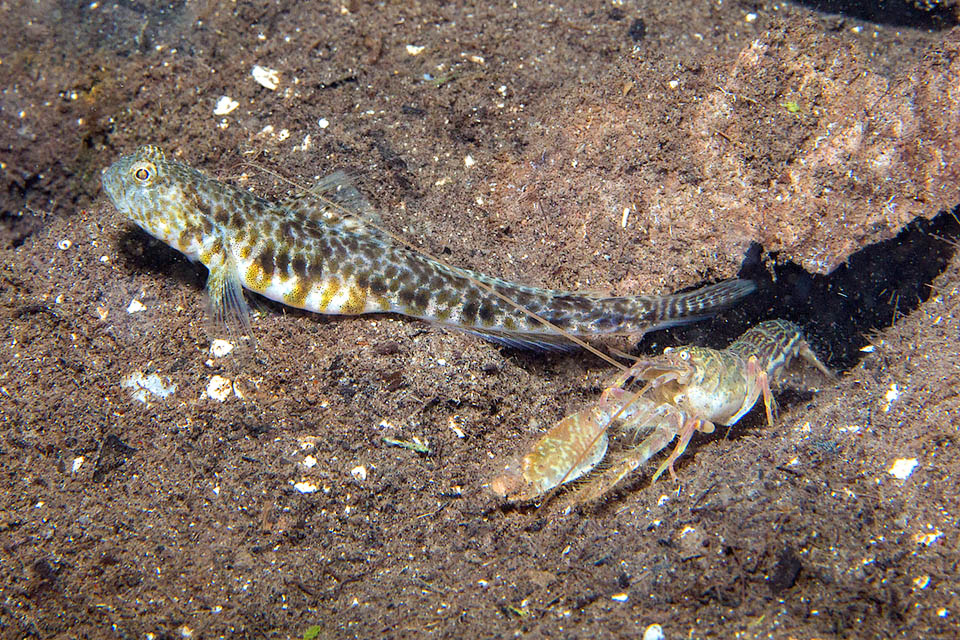
To survive it has then associated with Alpheus floridanus, a digging shrimp poorly seeing, he also in danger because it hardly sees the incoming predators © Allison & Carlos Estape
Nes longus, belonging to the class of the Actinopterygii, the. ray-finned fish, to the order of the Gobiiformes and to the family of the Gobiidae, is so important for Alpheus floridanus that this one touches it ceaselessly with its very long antennae getting sure it doesn’t wander off, almost like a blind person who advances by tapping the pavement with his stick.
The unusual genus Nes, means strip of land emerging from the sea, so, something as long as the specific term longus, long in Latin, confirms, seen the fusiform and elongated look of this goby.
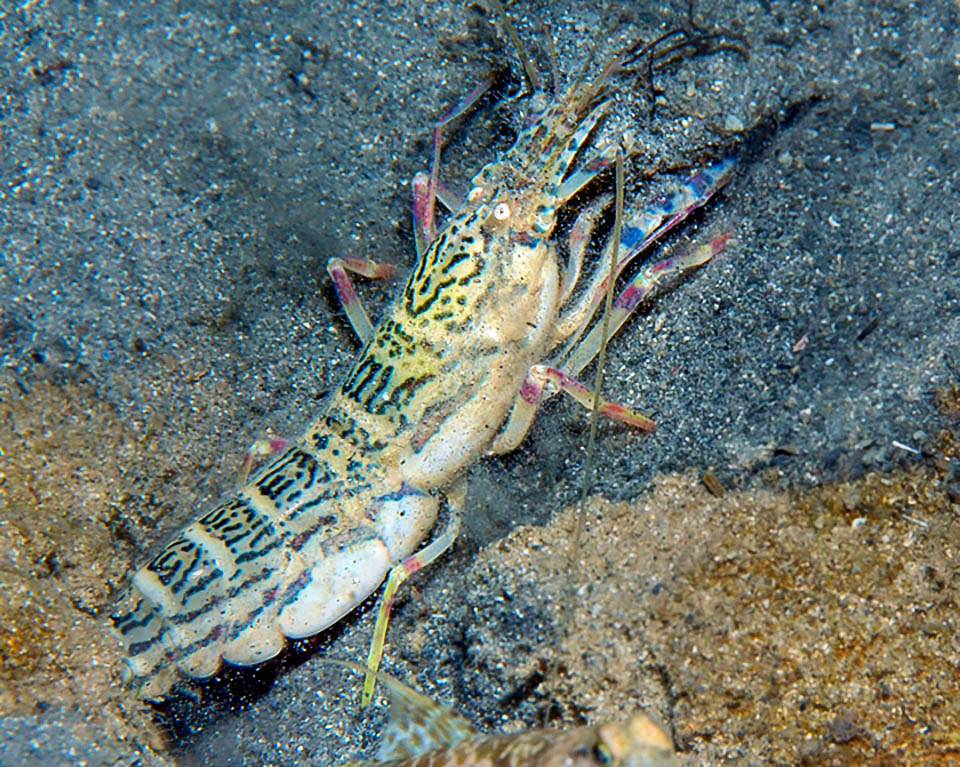
Here it is. Like the goby it’s less than 10 cm long, and when leaves the den looking for food is an easy prey for many © Pauline Walsh Jacobson
It is commonly called Orangespotted goby, due to the colour of its mimetic livery.
In reality, it often appears with darker shades forming in the lower part of the body a row of five double spots, black at times, ending in chevron designs on the caudal fin.
Zoogeography
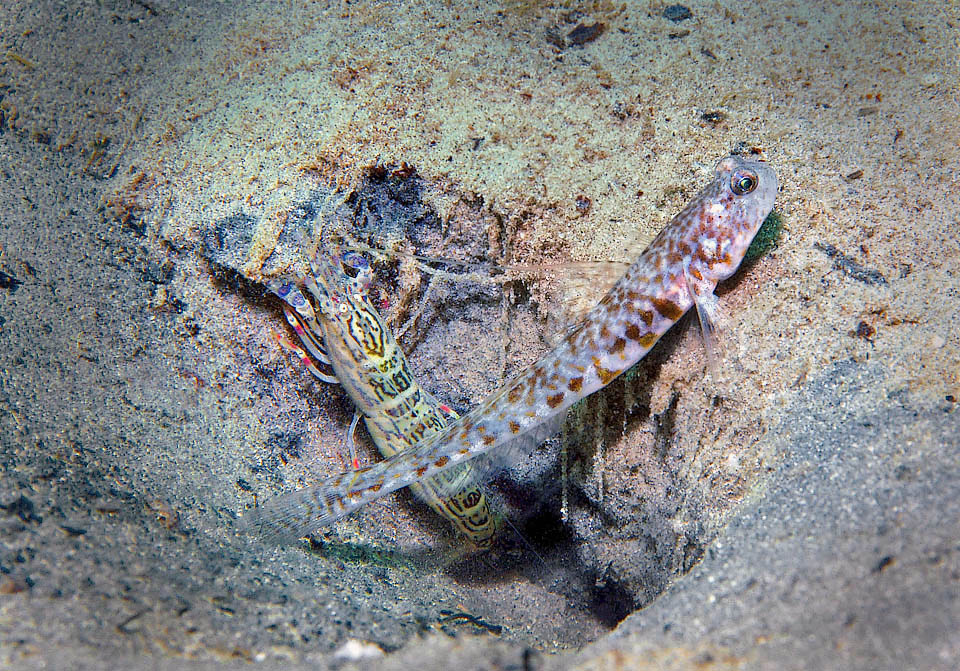
So they got together: the shrimp offers an underground shelter, and the goby acts as sentry, advising it with tail slaps on the seabed, if it sees a predator approaching © Pauline Walsh Jacobson
Nes longus lives in the western Atlantic from Bermudas up to Panama and Venezuela coasts.
Ecology-Habitat
It is found no deeper than 9 m on open bottoms, sandy and silty, in the locations where Alpheus floridanus. lives.
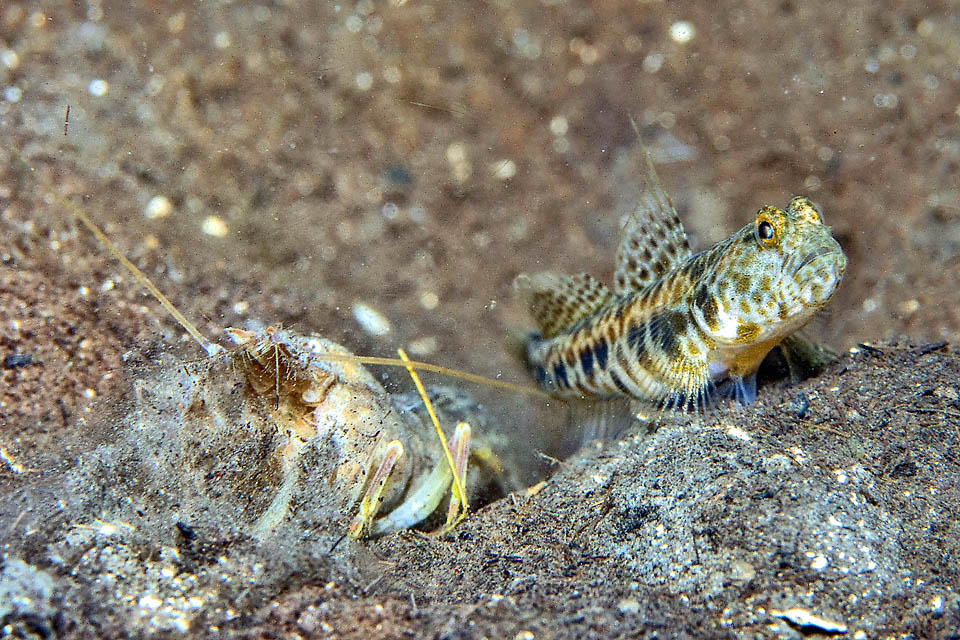
While Nes longus watches, Alpheus floridanus widens the den and does house cleaning also hunting down various small prey of the goby © Allison & Carlos Estape
Morphophysiology
Nes longus reaches at maximum the length of 10 cm, more or less the same size as its guest.
Its snout is short, blunt and big eyes placed on the top of the head. The mouth, slightly oblique, has 3-4 rows of teeth per jaw. The outer one is slightly bigger but we do not see showy canines and there are no teeth on the fore part of the palate.
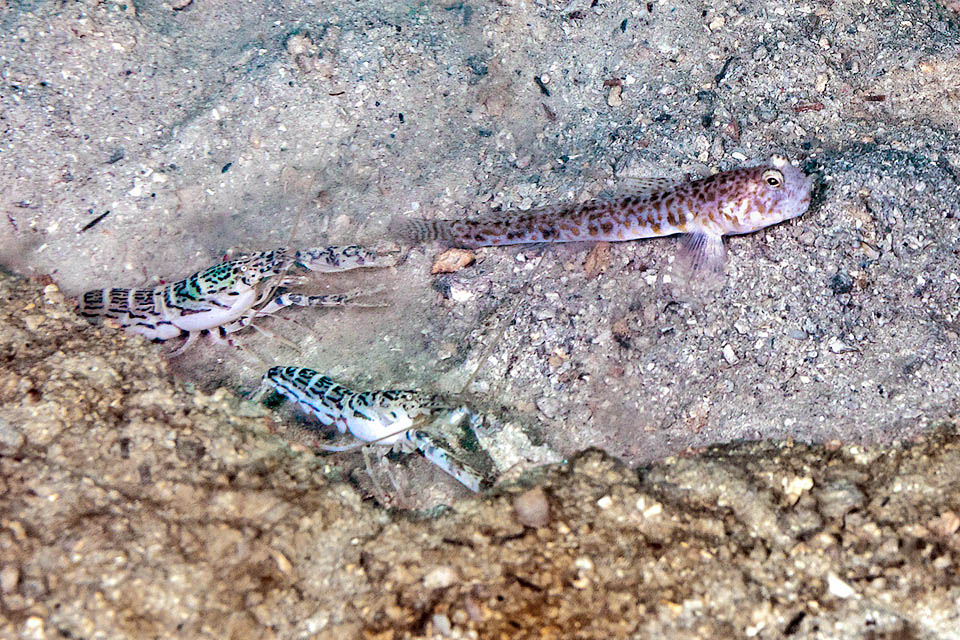
It is not rare that Nes longus lives with a couple of shrimps who cuddle it, touching it with their long antennae to ensure it’s always there, watching © Allison & Carlos Estape
The dorsal fin, split in two, has 7 spiny rays with the first one longer, and in the second part 1 spiny ray and 10-13 unarmed.
The anal has 1 spiny ray and 12 soft, the pectorals 16-19 rays, and the pelvic ones, merged, form an oval disc.
Ethology-Reproductive Biology
Alpheus floridanus feeds on plankton, algae, crabs, small fish and other shrimps it catches nearby.
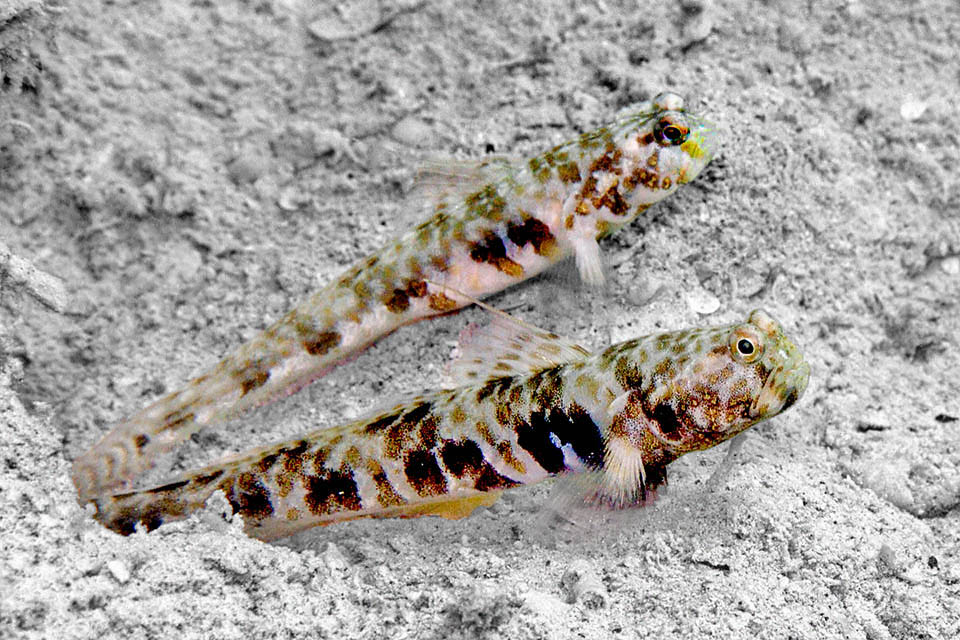
And are welcome in the den even pairs of gobies, with whom often share, for dinner, small fish and the crustaceans they managed to seize © Allison & Carlos Estape
Fearful as it is, it immediately carries the prey into the den sharing the meal with the friend goby who has covered its back.
Nes longus also gets food from the continuous excavations and maintenance works of its guest that carry out small gastropods, decapods, crustaceans, ostracods and isopods on which it feeds.
It is not rare that in the same den do live in perfect harmony also the pairs of these species that are so much taxonomically far away and this is the safest place chere to protect the eggs.
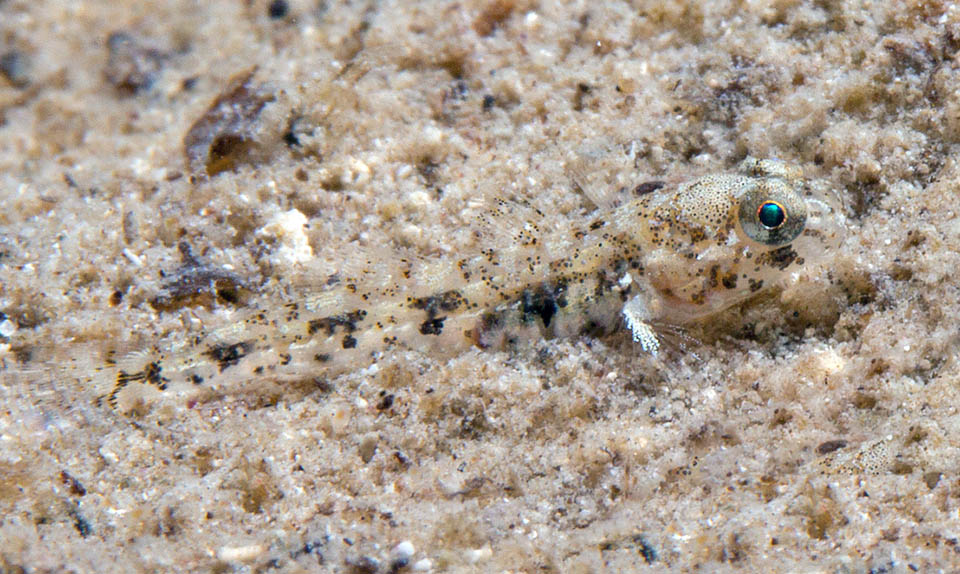
A juvenile goby has just left the den and ventures onto the seabed. The camouflage protection is perfect and now it looks for its Alpheus floridanus © Allison & Carlos Estape
Nes longus resilience is excellent with a possible doubling of the populations in less than 15 months. The fishing vulnerability, very low, marks only 10 on a scale of 100.
It comes from that since 2024 this species appears as “LC, Least Concern”, in the IUCN Red List of the endangered species.
Synonyms
Gobiosoma longum Nichols, 1914.
→ For general information about FISH please click here.
→ For general information about BONY FISH please click here
→ For general information about CARTILAGINOUS FISH please click here.
→ To appreciate the BIODIVERSITY of BONY FISH please click here.
→ To appreciate the BIODIVERSITY of CARTILAGINOUS FISH please click here.
